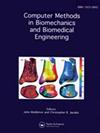A robust deep learning-driven framework for detecting Parkinson's disease using EEG.
IF 1.6
4区 医学
Q3 COMPUTER SCIENCE, INTERDISCIPLINARY APPLICATIONS
Computer Methods in Biomechanics and Biomedical Engineering
Pub Date : 2025-09-10
DOI:10.1080/10255842.2025.2556310
引用次数: 0
Abstract
Parkinson's disease (PD) is a neurodegenerative condition that impairs motor functions. Accurate and early diagnosis is essential for enhancing well-being and ensuring effective treatment. This study proposes a deep learning-based approach for PD detection using EEG signals. First, a channel attention module refines the EEG data. Then, wavelet scattering transform generates time-frequency maps from EEG. Subsequently, a GAN (Generative Adversarial Network) model is designed to generate more similar time-frequency maps of PD-affected patients as well as healthy control subjects. An efficient CNN-Transformer-based model is designed and trained using the augmented time-frequency map images, achieving 99.52% accuracy.
基于脑电图的帕金森病检测的鲁棒深度学习驱动框架。
帕金森病(PD)是一种损害运动功能的神经退行性疾病。准确和早期诊断对于增进福祉和确保有效治疗至关重要。本研究提出了一种基于深度学习的脑电信号PD检测方法。首先,利用通道关注模块对脑电数据进行细化处理。然后,对脑电信号进行小波散射变换生成时频图。随后,设计了GAN(生成对抗网络)模型,以生成pd患者和健康对照受试者更相似的时频图。利用增强的时频图图像,设计并训练了一种高效的基于cnn - transformer的模型,准确率达到99.52%。
本文章由计算机程序翻译,如有差异,请以英文原文为准。
求助全文
约1分钟内获得全文
求助全文
来源期刊
CiteScore
4.10
自引率
6.20%
发文量
179
审稿时长
4-8 weeks
期刊介绍:
The primary aims of Computer Methods in Biomechanics and Biomedical Engineering are to provide a means of communicating the advances being made in the areas of biomechanics and biomedical engineering and to stimulate interest in the continually emerging computer based technologies which are being applied in these multidisciplinary subjects. Computer Methods in Biomechanics and Biomedical Engineering will also provide a focus for the importance of integrating the disciplines of engineering with medical technology and clinical expertise. Such integration will have a major impact on health care in the future.

 求助内容:
求助内容: 应助结果提醒方式:
应助结果提醒方式:


